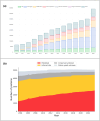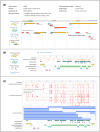PomBase: a Global Core Biodata Resource-growth, collaboration, and sustainability
- PMID: 38376816
- PMCID: PMC11075564
- DOI: 10.1093/genetics/iyae007
PomBase: a Global Core Biodata Resource-growth, collaboration, and sustainability
Abstract
PomBase (https://www.pombase.org), the model organism database (MOD) for fission yeast, was recently awarded Global Core Biodata Resource (GCBR) status by the Global Biodata Coalition (GBC; https://globalbiodata.org/) after a rigorous selection process. In this MOD review, we present PomBase's continuing growth and improvement over the last 2 years. We describe these improvements in the context of the qualitative GCBR indicators related to scientific quality, comprehensivity, accelerating science, user stories, and collaborations with other biodata resources. This review also showcases the depth of existing connections both within the biocuration ecosystem and between PomBase and its user community.
Keywords: Schizosaccharomyces pombe; FAIR; Global BioData Coalition; Global Core Biodata Resource; MOD; biocuration; database; fission yeast; knowledgebase; model organism; model organism database; standardization.
© The Author(s) 2024. Published by Oxford University Press on behalf of The Genetics Society of America.
Conflict of interest statement
Conflicts of interest: The authors declare no conflicts of interest.
Figures






References
Publication types
MeSH terms
Grants and funding
LinkOut - more resources
Full Text Sources

